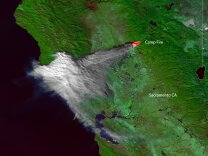
Next Up:
0:00
0:00
-
Listen Listen
Climate & Environment
Researchers found that in drier years, larger animals are more likely to head closer and closer to where people live.
Listen
4:05
Sponsored message
More Stories
-
Visitors are welcome to catch the rare sight — and smell — in person for free. Or watch it bloom through the Huntington's livestream.
-
The digital tool led by UCLA offers residents real-time measurements of particles in the air.
-
Uncertainty around the future of the state’s emissions trading program has disrupted credit auctions and lowered state revenue.
-
Under the second Trump administration, climate denial has given way to climate erasure.
-
The real, killer stuff from an era before state regulation, before car emission technology, before unleaded gasoline. Enjoy.
-
Flood risk will be elevated into Saturday in mountain and high desert areas, the National Weather Service warns.
-
A conflict in the Imperial Valley offers a window into an increasingly sharp debate within California's $60 billion agricultural sector over what should happen as acreage devoted to crops and livestock shrinks.
-
Survivors say they're frustrated with the complicated application process while trying to decide if they'll rebuild or relocate.
-
Dozens of people turned out for a town hall Wednesday night, with nearly all voicing opposition to the moratorium plan.
-
The Board of Supervisors is considering establishing a "heat threshold" of 82 degrees. It will go to a vote next month.
-
Fungal spores, a significant but often overlooked allergy, are now appearing earlier in the year due to climate change. If your springtime allergies have felt sneezier and sneezier, you might be right.
-
L.A. County could see some showers and thunderstorms as early as the afternoon.
The heaviest rainfall fell overnight Thursday into Friday morning in the L.A. and Ventura counties with continued showers into the weekend.
Support your source for local news!
In case you missed it
-
911 recordings obtained by LAist shed light on why and how emergency planning continues to leave people with disabilities behind.
-
LAist investigates illicit dumping at three Antelope Valley sites.
-
An LAist investigation found toxic heavy metals in samples of fire retardant collected from the Palisades, Eaton and Franklin fires. Here's what that means.
More Stories
-
Officials expect the emergency-use vaccine to partially protect the critically endangered species from the deadly avian influenza virus.
-
We're looking at another warm week — here's what you need to know.
-
Across the US, local governments, lobbyists and industry have spent millions to get wildfire pollution excluded from the record. People like Robert Shobe pay the price
-
We're looking at another warm week — here's what you need to know.
-
A new government report finds that September was the hottest in the agency's 174-year global climate record. Climate change and El Niño are driving the heat.
-
Wildfires cause billions in home damage every year. Now, insurers no longer want to take on the risk.
-
Major investigation shows local governments are increasingly exploiting a loophole in the Clean Air Act, leaving more than 21 million Americans with air that’s dirtier than they realize. California leads the nation it its use.
-
First pushed through by the Republican senator and climate denier Jim Inhofe, the rule has become a "regulatory escape hatch" for states that want to meet federal air-quality standards.
-
The area is a longstanding concern for fire experts because it has just a handful of narrow roads to evacuate thousands of residents.
-
A number of wild predators have fallen prey to poisoned rats




































